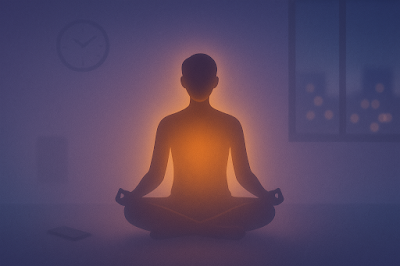The Science of Pratyahara (Withdrawal of the Senses)
Today we’re digging into Pratyahara. Ever heard of it? It’s all about withdrawing the senses, it’s a game-changer. In yoga, Pratyahara acts like a bridge, connecting the busy external world to that quiet, peaceful inner space we all crave. It’s the fifth limb in Patanjali’s Yoga Sutras, and it’s all about sense control, focusing on mastering our sense organs to achieve inner calm. Ready to explore how it works, why it matters, and how you can practice it? Let’s get started.
What Is Pratyahara Anyway?
Pratyahara might sound fancy, but it’s pretty simple when you break it down. Pratyahara is about turning your senses inward instead of letting them chase every sight, sound, or notification out there. It’s not about blocking the world. It’s about choosing what you let in.
In the yoga system, Pratyahara sits right after the first four limbs: Yamas (how we treat others), Niyamas (how we treat ourselves), Asana (physical postures), and Pranayama (breath control). It’s the fifth limb, setting you up for the big stuff like meditation and focus. Think of it as the forgotten limb that helps you shift from outer chaos to inner calm. Incorporating pratyahara into various yoga practices can help foster a deeper awareness and engagement with both personal and socio-political realities.
History and Evolution of Pratyahara
Pratyahara, the fifth limb of yoga, has a rich history that dates back to ancient India. The concept of Pratyahara is first mentioned in the Yoga Sutras of Patanjali, a foundational text of yoga philosophy. In these sutras, Patanjali describes Pratyahara as the process of withdrawing the senses from external stimuli and turning inward, a crucial step in the journey towards inner peace and self-realization.
Over the centuries, the concept of Pratyahara has evolved and been interpreted in various ways by different yoga traditions. In the Hatha Yoga tradition, Pratyahara is seen as a means of preparing the body and mind for meditation and spiritual growth. It’s like tuning an instrument before a performance, ensuring everything is in harmony. In the Raja Yoga tradition, Pratyahara is viewed as a way of cultivating inner awareness and self-regulation, helping practitioners to master their mind and emotions.
In modern times, Pratyahara has been adapted to suit the needs of contemporary yoga practitioners. Many yoga styles, such as Hatha, Vinyasa, and Restorative Yoga, incorporate Pratyahara into their practices, recognizing its value in achieving a balanced and focused state of mind. Additionally, Pratyahara has been influenced by other spiritual traditions, such as Buddhism and Taoism, which also emphasize the importance of withdrawing the senses and turning inward.
Despite its evolution, the core principles of Pratyahara remain the same: to withdraw the senses from external stimuli, cultivate inner awareness, and prepare the mind and body for meditation and spiritual growth. It’s a timeless practice that continues to offer profound benefits in our fast-paced, sensory-overloaded world.

Why Pratyahara Matters in Yoga Practice
So why should you care about Pratyahara in your yoga practice? Well, life’s loud, right? Between phones buzzing and schedules piling up, our senses get overwhelmed. Pratyahara steps in to help. It’s like a reset button for your mind, body, and senses. By practicing Pratyahara, you get to decide where your attention goes instead of letting the external world yank it around.
This fits right into Harmony Centered’s vibe. We’re all about finding peace and balance, and Pratyahara is a key to that. It’s not just some old yoga philosophy trick either. It’s practical and totally doable, even in our busy daily life.
Pratyahara as a Bridge Between Worlds
Pratyahara is the bridge between the external world and your inner self. In yoga philosophy, mastering the sense organs is crucial for this shift, as they can often distract us from our inner focus. The first four limbs of yoga keep you grounded out there: moving your physical body, breathing right, living kindly. But then Pratyahara swoops in to guide you inward. It’s the first stage of turning your focus from sense objects like that tempting coffee smell or a loud car horn to something deeper inside.
In yoga philosophy, this shift is huge. It preps you for the next stages: concentration, meditation, and that pure consciousness we all dream of. Without Pratyahara, your senses might keep pulling you back to the outside world. With it, you’re on your way to inner peace.
The Science Behind Sense Control
Okay, let’s talk science for a sec because Pratyahara isn’t just woo-woo stuff. It’s got some real backup. Our five senses (sight, sound, touch, taste, smell) are wired into our nervous system. When they’re on overdrive, grabbing at every sensory input, we get stressed. Ever feel fried after too much screen time? That’s sensory overload in action.
Pratyahara flips the script by teaching us to withdraw our sense organs from external stimuli, allowing our brain to chill out. Studies show mindfulness (which Pratyahara vibes with) lowers activity in sensory processing zones. Your nervous system thanks you with deep relaxation. Plus, in yoga, breath control helps. Slow breaths calm your body, making it easier to let go of external stimuli and focus inward.
How Your Senses Play a Role
Let’s zoom in on those senses. Your five senses are like little messengers, always chatting with the external world. That’s great until they won’t stop. Pratyahara teaches you to gently hush your sense organs, not ignoring them but not letting them run the show either. It’s not about ignoring a bird chirping or your kid calling. It’s about not letting those sense objects run the show.
Say you’re in a stimulating environment, like a crowded store. Normally, your senses might freak out: lights, chatter, smells everywhere. With Pratyahara, you can dial it back, finding inner calm even when the outside world won’t quit.
Pratyahara in the Yoga Sutras
Patanjali, the yoga sage, knew what he was doing with the Yoga Sutras. He lists Pratyahara as the fifth limb in his eight limbs of yoga. It’s not some random step. It’s on purpose, coming right before the mind stuff gets real with meditation and focus. The Sanskrit word Pratyahara hints at its power: conscious withdrawal from what’s outside to what’s inside.
Patanjali says it’s about mastering the senses, not being their puppet. That’s a big deal in yoga practice because it’s how you move from physical postures to that higher self stuff yogis talk about.
Why It’s the Forgotten Limb
Here’s a fun fact: some call Pratyahara the forgotten limb. Why? It’s not as flashy as a killer asana or as obvious as breathing exercises. But don’t sleep on it. Without this fifth limb, your yoga practice might stay stuck in the body instead of reaching your true self. It’s the quiet hero of the yoga system.
Benefits of Practicing Pratyahara
Practicing Pratyahara offers numerous benefits for the body, mind, and spirit. Here’s a closer look at how this practice can enhance your overall well-being:
- Reduced Stress and Anxiety: By withdrawing the senses from external stimuli, Pratyahara helps to calm the mind and reduce stress and anxiety. It’s like hitting the pause button on the chaos around you, allowing your nervous system to reset and relax.
- Improved Focus and Concentration: Pratyahara helps to cultivate inner awareness and focus, leading to improved concentration and mental clarity. When you’re not constantly distracted by the external world, your mind can zero in on what truly matters.
- Increased Self-Awareness: By turning inward, Pratyahara helps to increase self-awareness, allowing practitioners to better understand their thoughts, emotions, and behaviors. It’s a journey of self-discovery that can lead to profound personal growth.
- Enhanced Creativity: Pratyahara can help to stimulate creativity by allowing practitioners to tap into their inner sources of inspiration. When the noise of the outside world fades, your creative juices can flow more freely.
- Better Sleep: Pratyahara can help to improve sleep quality by calming the mind and body before bed. A quiet mind is a restful mind, making it easier to drift into deep, restorative sleep.
- Increased Sense of Calm and Relaxation: Pratyahara can help to reduce feelings of overwhelm and increase feelings of calm and relaxation. It’s like finding an oasis of peace in the midst of a busy day.
Overall, practicing Pratyahara can have a profound impact on both physical and mental health, leading to a greater sense of well-being and overall quality of life. It’s a powerful tool for navigating the demands of modern life with grace and ease.
Practicing Pratyahara in Daily Life
You can weave it into daily life, and it’s easier than you think. It’s all about small moments of sensory withdrawal. Maybe you’re sipping tea and really tasting it instead of scrolling your phone. That’s Pratyahara.
Or try this: next time you’re stressed, close your eyes for a minute. Let the external senses fade and feel your breath. That’s the start of sense control, and it helps calm you fast. Incorporating pratyahara into your daily yoga practices can make these moments of sensory withdrawal more effective and meaningful.

A Meditation Sequence to Try
Ready to practice Pratyahara with meditation? Here’s a simple sequence you can do anywhere. It’s about 5-10 minutes and perfect for Harmony Centered folks wanting inner peace.
- Settle In: Sit comfy, maybe on a folded blanket, palms facing up. Close your eyes.
- Breathe Easy: Take 5 slow breaths. Feel the air move in and out. Let your body soften.
- Sense Check: Notice your five senses one by one. What do you hear? Smell? Feel on your skin? Don’t judge, just notice.
- Let Go: Picture each sense pulling back, like waves retreating from the shore. Start with sound, then touch, then the rest.
- Rest Inside: Sit in that quiet space for a few minutes. If your mind wanders, bring it back to your breath.
This is conscious withdrawal in action. It’s a powerful tool for stress relief and finding your inner self.
A Yoga Flow for Pratyahara
Let’s move with it now. This yoga flow is all about grounding and turning your attention inwards. It’s gentle, so anyone can try it. Grab a mat and flow with me.
- Child’s Pose (Balasana): Kneel, fold forward, and rest your forehead down. Stay for 5 breaths. Feel your senses soften.
- Cat-Cow: On all fours, arch and round your back for 5 rounds. Sync it with your breath.
- Thread the Needle: Slide one shoulder to the ground, rest, and breathe for 5 counts. Switch sides. This quiets the mind stuff.
- Forward Fold (Uttanasana): Stand, bend forward, and hang out for 5 breaths. Let the external world drop away.
- Seated Twist: Sit cross-legged, twist gently each way, 3 breaths per side. Focus inward.
- Savasana: Lie flat, palms up, for 5 minutes. Imagine your senses sinking into calm.
This flow helps calm your body and senses, making Pratyahara feel natural.
Journaling Prompts for Reflection
Want to go deeper? Grab a notebook and try these journaling prompts. They’re all about connecting Pratyahara to your life.
- What’s one external thing (sound, sight, etc.) that pulls my focus most? How can I soften its grip?
- How do I feel when my senses get quiet? What’s my true nature like in that space?
- Where in my daily life could I practice withdrawing my senses for a minute or two?
- What does inner peace look like for me? How can Pratyahara get me there?
- How does my yoga practice change when I focus on my inner self instead of the outside world?
These prompts tie into Harmony Centered’s mission of self-awareness and calm.
Pratyahara and Stress Relief
Let’s circle back to why this matters. Sensory overload is real, and it messes with our nervous system. Practicing Pratyahara means remaining steady even when life’s wild. It’s stress relief you can carry anywhere. Whether it’s yoga nidra (yogic sleep) or just a quick breath break, you’re training your senses to chill out.
Connecting to Your Higher Self
Here’s the big picture. Pratyahara isn’t just about dodging sensory stimulation. It’s a step toward your higher self, that pure consciousness Patanjali hints at. By practicing non-attachment to sense objects, you peel back layers of mind stuff and get closer to your true nature.

Tips for Practicing Pratyahara
Before we wrap up, here are some quick tips to keep Pratyahara alive in your yoga practice.
- Start small: Try focusing on one sense (like sound) and letting it fade for a minute.
- Use breath: Slow breathing is your secret weapon for sensory withdrawal.
- Mix it with asana: Fold forward in poses to turn your attention inwards.
- Try yoga nidra: It’s like Pratyahara on autopilot.
- Be patient: Your senses might resist at first, but they’ll get the hang of it.
Wrapping It Up
So there you go, friends! Pratyahara is this amazing fifth limb that bridges the external world and your inner calm. It’s a science-backed, yoga-approved way to master your senses and find peace. Whether you’re flowing through asana, sitting in meditation, or journaling your heart out, practicing Pratyahara brings you closer to that Harmony Centered life we love. What do you think? Try the sequence or prompts and let me know how it feels. Namaste!






